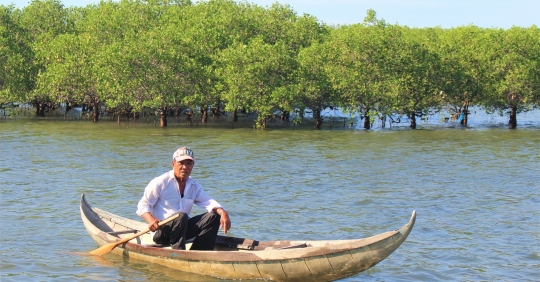Mangroves stimulate aquaculture
According to Mr. Truong Xuan Dua, head of Agricultural Technology Research and Application Station of Binh Dinh Agricultural Advisory Center, mangrove planting has previously only been done in Con Chim Ecological Zone, Vinh Quang 2 Village, Phuoc Township, Son (Tuy Phuoc District, Binh Dinh). now expanding the tidal flats along the Thi Nai and De Gi lagoons in accordance with the provincial-approved afforestation plan.
The method of planting mangroves in Binh Dinh is that the state plants and takes care of the trees for the first 5 years, when the trees have become forests, they are subcontracted to people along the Thi Nai and De Gi lagoons in order to to protect them with the contract rate of 300,000 VND/ha/year.
Up to now, the total area of mangrove forest in Binh Dinh covers more than 88 ha of concentrated planted forest and 1,000 ha of scattered planted forest in Thi Nai and De Gi lagoons. Specifically, in 2022, Binh Dinh Agricultural Extension Center will plant 2,100 new mangrove trees along tidal flats and embankments in Con Chim Ecological Area – Thi Nai Lagoon.
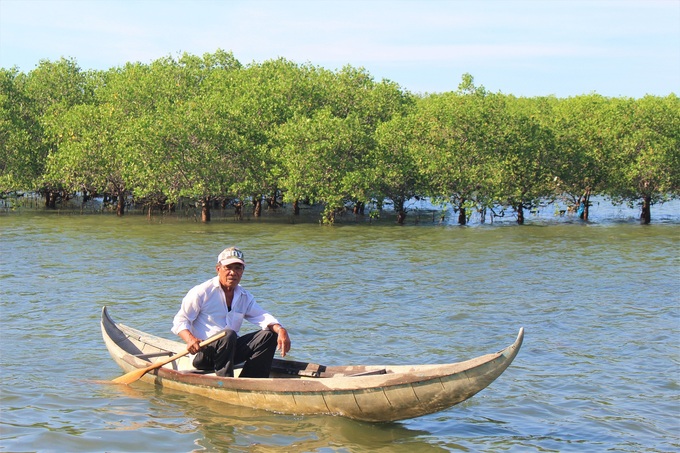
Mr. Duong Van Tuong from Phuoc Thuan Township (Tuy Phuoc District, Binh Dinh) inspects his integrated aquaculture pond. Picture: VDT
When the settlements along the Thi Nai and De Gi lagoons are green again with mangrove forests, the aquaculture of the lowland people (dwellers near the sea, near the dike) revives greatly thanks to the aquatic environment purified for the better.
According to Mr. Nguyen Ngoc Hai (born 1961), former MP of Vinh Quang Village 2, Phuoc Son Township (Tuy Phuoc District, Binh Dinh), Con Chim is in charge of Con Chim Village after Con Chim restores mangroves and aquaculture hat are revived thanks to the roots of the forest trees that purify the water source.
Today, people no longer specialize in shrimp farming, but in improved and environmentally friendly multi-species farming. Every year during the rainy season, after eating the Lunar New Year, people strengthen the banks of the pond. When the weather is stable, buy shrimp, crab and seedlings for the stocking.
“Currently, the people of Con Chim are engaged in aquaculture in the mangrove forest in the form of pruning and clearing according to the guidance of the provincial Agricultural Advisory Center. Integrated aquaculture in mangroves, farmers don’t have to spend a lot of money and consume less food thanks to feeding in nature. Due to the close-to-nature attitude, shrimp, crabs and fish are less susceptible to diseases and have a regular income every day.
My family has 2 hectares of ponds, every year I gain 300-400 million VND/year, every year I lose 200 million VND. Although the income is not as high as that of intensive shrimp farming, people’s lives here are much more stable than that of specialized shrimp farming as before,” Mr Hai said.
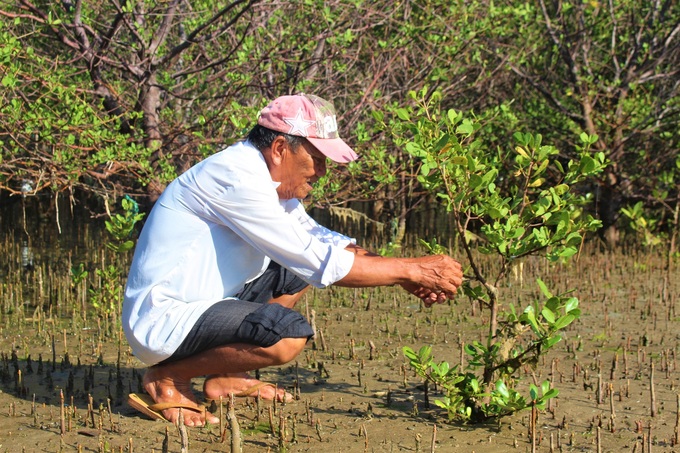
Mr. Duong Van Tuong in Phuoc Thuan Township (Tuy Phuoc District, Binh Dinh) raised mangrove trees for planting. Picture: VDT
According to Mr. Truong Xuan Dua, from 2010 to date, units of the Ministry of Agriculture and Rural Development and the Ministry of Natural Resources and Environment of Binh Dinh have coordinated and implemented many programs, including: Project “Improvement of dike system and planting trees” mangrove forest in response to climate change in Thi Nai Lagoon”; the project “Ecosystem services create resilience to change in Quy Nhon City”; Project “Green Shield Strengthens Response Capabilities of Coastal Communities to Impacts of Natural Disasters”; Project “Improving Responsiveness to Climate Change in Quy Nhon City”…
“In the above projects, we work with local authorities and people to plant, nurture, protect and regenerate mangroves. In addition, in early March, Binh Dinh Agricultural Extension Center organized training for more than 40 coastal aquaculture households on integrated shrimp-crab-fish culture techniques in ecological ponds with brackish water mangrove Thi Nai Lagoon in 2 communes of Phuoc Thuan and Phuoc Hoa (district Tuy Phuoc).
Fishermen were trained in pond improvement techniques and water treatment before stocking; correct and standard selection of breeding cattle; Techniques for feeding, maintenance and management of ponds; Prevention and treatment of some common diseases in shrimp, crab and fish; The technique of changing water helps mangroves grow and promotes the function of water filtration to help farmers achieve the highest economic efficiency when raising many objects in the same pond,” said Truong Xuan Dua.
Taking care of the forest means keeping the job
According to experts in the field of forestry, mangroves are influenced by many factors such as tides, temperature, hydrology, etc. through the corresponding level of flooding and salinity. Mangroves are tasked with resisting tidal erosion, combating climate change and providing shelter to many plant and animal species.
according to dr Nguyen Dinh Thanh, head of the Department of Social Research (Institute for Socio-Economic Development Research of Binh Dinh Province), the mangroves in Binh Dinh are mainly concentrated in the Thi Nai and De Gi lagoons. However, in these areas, afforestation is difficult due to the less suitable salinity, temperature and substrate (silt, sand and mud), making forest development arduous.
Therefore, Binh Dinh is very interested in the protection and development of mangrove forests. Thanks to this, Binh Dinh mangrove area has been gradually restored and developed in recent years, which not only helps to protect the environment, reduce the risk of disasters, but also create an ecological landscape for development, develop tourism, make sustainable livelihoods for fishermen.
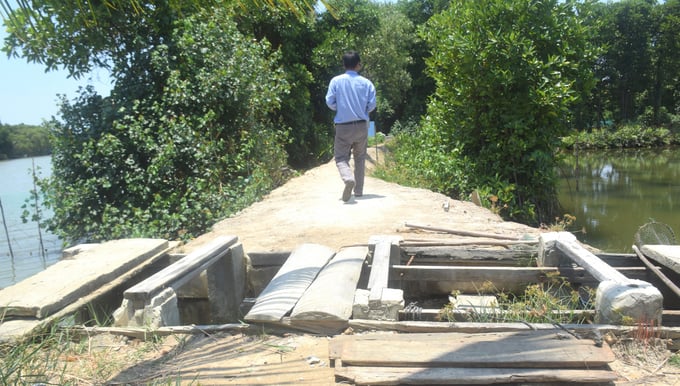
Mangrove trees are planted around the banks of aquaculture ponds to maintain their roots to improve the aquatic environment and preserve the banks. Picture: VDT
According to Mr. Vo Van Thanh, who raises shrimp and crab in Binh Thoi Village of Phuoc Thuan Township (Tuy Phuoc District, Binh Dinh), currently most of the local aquaculture farmers are all planting mangrove trees around the pond to improve the water environment . However, local people’s efforts to plant mangroves also encounter many difficulties, when the new tree has 4-6 leaves, it is often eaten by the barnacle and dies, or blown by the wind.Where have you planted before?
Mr. Duong Van Tuong in Phuoc Thuan Township (Tuy Phuoc District, Binh Dinh) not only gets a contract to protect 3 ha of mangroves, but also grows fish and mangrove trees himself to grow at the edge of his family’s nearly 3 ha aquaculture pond plant family.
“Not only me, many households here have also seeded mangroves around the aquaculture area themselves to prevent erosion and create a green landscape. Every year around the fourth lunar month the cork begins to fruit, which lasts until the beginning of October, from the time of cork flowering to the age of the fruit is 3 ½ months, then it is possible to pick the fruit and plant the seedlings.
In addition to the acidic and sharp cork, fish and mangrove trees also grow in the mangroves of Thi Nai Lagoon. Mam tree and mangrove trees are the fruit picking season for sowing in July and August every year,” Mr. Tuong said.
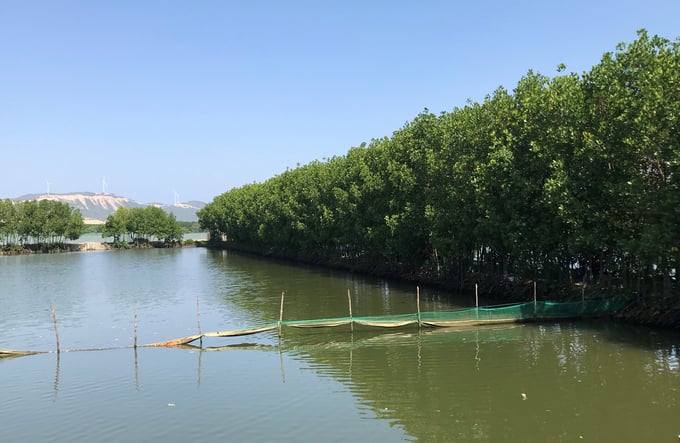
Mangroves provide shelter for integrated shrimp, crab and fish aquaculture. Picture: VDT
Pointing to the mangrove trees planted at the edge of his aquaculture pond, Mr. Tuong continued his story: “The mangrove tree has roots winding deep into the ground like an arch, this type of root is said to hold the banks deliciously. In the stormy years, thanks to the rows of mangroves, the shore of my shrimp pond was not eroded, not destroyed by strong tides and waves, and during the stormy season I did not have to pay for bank protection. Mangrove roots support crab-infested shrimp farming – fish are very wild, especially the roots of fish trees, cork oaks, their roots attract many aquatic creatures to live, when they grow up, this is an additional income for people.
“Integrated aquaculture with shrimp – crab – fish must change the water according to the tide, because the water in the pond is missing, when the tide rises, it must be added to add about 20-30cm of water. Aquaculture ponds carry water in and out and create conditions for mangrove growth. If the water is held too long, the mangroves will die,” said Truong Xuan Dua, head of Agricultural Technology Research and Application Station at the Ministry of Agriculture and Rural Development. Binh Dinh Agricultural Extension Center said.

